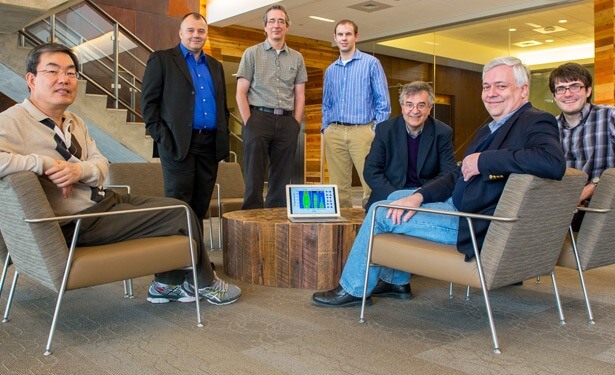Northern Illinois University physics professor Omar Chmaissem, an NIU alumnae and a current postdoctoral student are key members of a team of scientists at the U.S. Department of Energy’s Argonne National Laboratory shedding light this week on the mysteries of superconductivity.
In a study published today in “Nature Communications,” the team announces the discovery of a previously unknown transition phase in a class of superconductors called iron arsenides. The finding illuminates the debate over the electronic interactions responsible for superconductivity.
The science and tech communities have long been fascinated with the amazing properties of superconductors. When cooled below certain temperatures, they conduct electricity without energy-sapping resistance.
Superconductors are already used in Magnetic Resonance Imaging (MRI) devices, in the transportation industry and in scientific-research equipment, including particle accelerators. But the best known superconducting materials can operate only below 218 degrees Fahrenheit under ambient pressure.
For decades, scientists have been on a quest to develop room-temperature superconductors, which could revolutionize the energy industry and lead to many more applications, such as magnetically levitated superfast trains, powerful supercomputers and devices that now only exist in the imaginations of science fiction writers.
It’s well known that superconducting materials lose their resistance below a certain temperature, which is usually near absolute zero (−459.6 Fahrenheit). They also dislike magnetism and do not allow magnetic field lines to penetrate through the materials.
“But a full understanding of the theory of superconductivity remains elusive,” said Chmaissem, a Naperville resident and NIU physics professor who holds a long-term collaborative appointment at Argonne.
“Working with a particular class of iron-based magnetic materials, our team discovered a novel magnetic state just when the material is about to become superconducting,” he says. “This is important to theorists and experimentalists as they try to create novel materials with superconducting properties at room temperature.”

Members of the Argonne team (from left): Duck-Young Chung, Omar Chmaissem, Stephan Rosenkranz, Daniel Bugaris, Mercouri G. Kanatzidis, Ray Osborn and Jared M. Allred
At NIU, Chmaissem teaches a wide range of courses, from general physics to electricity and magnetism to analytical mechanics. The first author on the new research paper is Chmaissem’s former postdoctoral fellow Sevda Avci, who earned her Ph.D. in physics at NIU and is now at Afyon Kocatepe University in Turkey. Jared Allred, one of Chmaissem’s current postdoctoral students, also was a member of the team.
The research was performed at the ISIS Pulsed Neutron and Muon Source at the Rutherford Appleton Laboratory in Oxfordshire, U.K., using a method known as neutron powder diffraction.
Superconductors are notably finicky. In order to get to the superconducting phase—where electricity flows freely—they need a lot of coddling. The iron arsenides the researchers studied are normally magnetically ordered, but as you add sodium to the mix, the magnetism is suppressed and the materials eventually become superconducting below roughly -400 degrees Fahrenheit.
Magnetic order affects the atomic structure. At room temperature, the iron atoms sit on a square lattice, which has four-fold symmetry, but when cooled below the magnetic transition temperature, they distort to form a rectangular lattice, with only two-fold symmetry.

A neutron diffraction image giving evidence for the new magnetic phase in iron-based superconductors discovered by Argonne scientists. It shows the scattering results from a sample of barium iron arsenide with sodium ions added to 24 percent of the barium sites. Nematic order sets in below 90 K but four-fold symmetry is restored below 40 K. The resulting atomic and magnetic structures are illustrated in the figure on the right, in which the blue spheres represent iron atoms and the red arrows show the direction of their magnetic moments. Image by Jared Allred.
The Argonne team discovered a phase where the material returns to four-fold symmetry close to the onset of superconductivity.
“Our new discovery shows that there’s a novel four-fold symmetrical magnetic state above superconductivity,” Chmaissem said. “Further, this magnetic state and superconductivity compete against each other at lower temperature and manage to coexist. There’s no return to the two-fold symmetry. This was completely unexpected and is now subject to extensive theoretical work by collaborators and competitors alike.”
The research paper is titled “Magnetically Driven Suppression of Nematic Order in an Iron-based Superconductor.”
Other coauthors on the paper were Argonne scientists Ray Osborn, Stephan Rosenkranz, Daniel Bugaris, Duck Young Chung, John-Paul Castellan, John Schlueter, Helmut Claus and Mercouri Kanatzidis (a joint appointment with Northwestern University); Ilya Eremin at the Institut für Theoretische Physik in Germany; Andrey Chubukov at the University of Wisconsin-Madison; and ISIS scientists Dmitry Khalyavin, Pascal Manuel and Aziz Daoud-Aladine.

